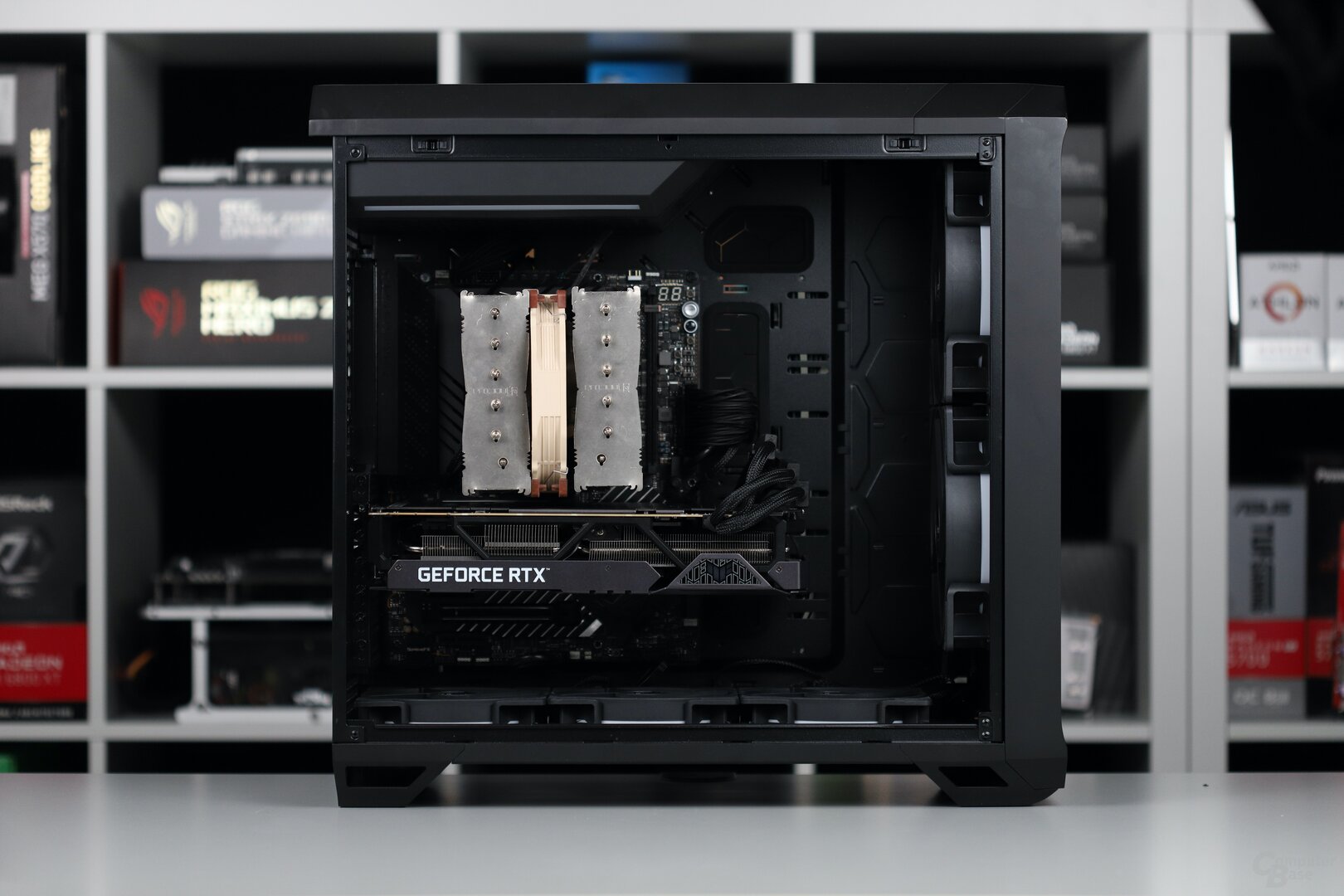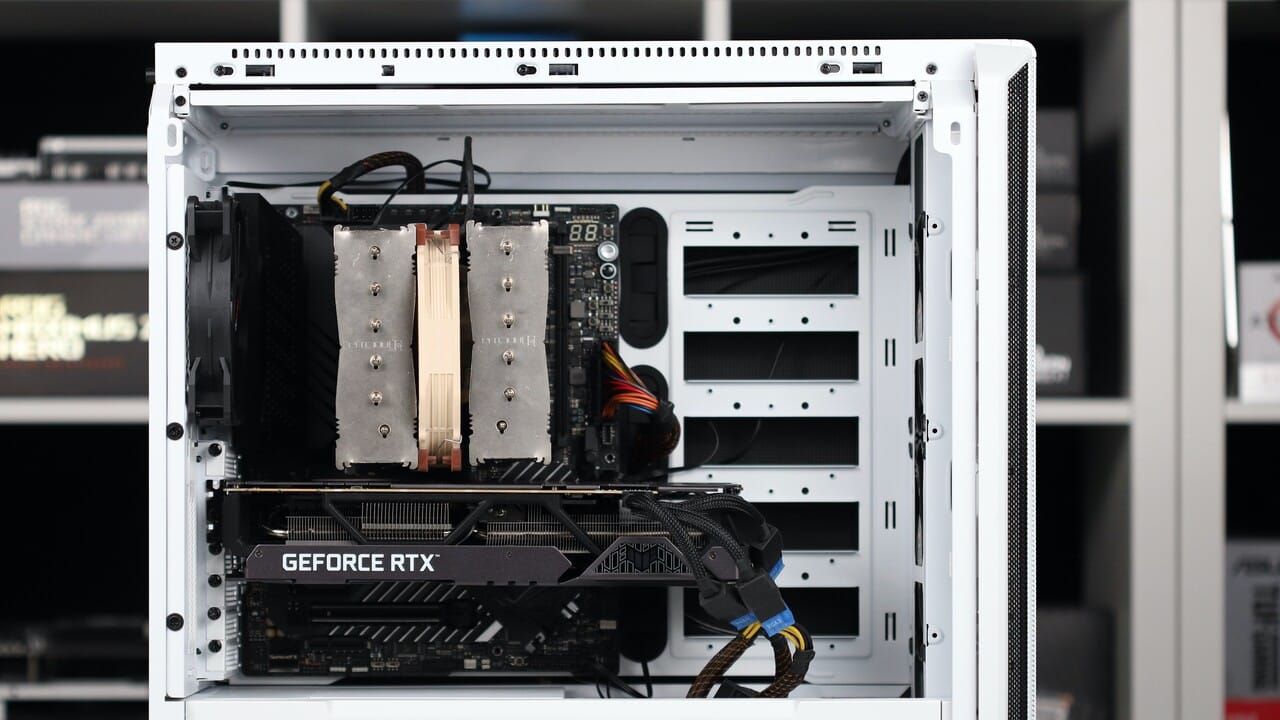Enclosures will determine the volume
: Test |CUP | Specs |Config
The next-gen graphics cards AMD RDNA 3 (RX 7000) and Nvidia Ada (RTX 4000) should absorb up to 600 watts and possibly even more. The GeForce RTX 3090 Ti is a first pointer with 450 watts. The test of the Ti in three housings shows: Even 450 watts present many housings with a virtually impossible task.
Updated 05/23/2022 12:26 p.m
A TDP of 450 watts is a challenge for a case
In the ComputerBase test, the Asus GeForce RTX 3090 Ti TUF OC was unusually loud. Due to the permitted TDP of 450 watts, this is not surprising at first glance, but with the measured 52 dB – and this is only available in the Quiet BIOS – there was an annoying hiss.
That didn’t fit into the picture, because the TUF cooler used by Asus is basically identical to that of several other TUF models and has always been convincing. In addition, the GeForce RTX 3090 Ti TUF OC can rely on an enlarged heat sink and new fans, which Asus says are better. That the new flagship was louder than, for example, the GeForce RTX 3080 TUF OC (ComputerBase test): free. But not 16 dB louder.
“Heat accumulation”: When the waste heat remains in the housing
One day before the NDA fell, the enlightenment came, which was somehow obvious, but had not been considered as the cause due to the effects far exceeding expectations: The Asus GeForce RTX 3090 Ti TUF OC was therefore so loud, because she was bathing in her own waste heat. The case could no longer effectively dissipate the 450 watts of the GPU and about 200 watts of the other components. The GPU cooler fans had to rotate faster in this environment, and the volume increased significantly.
The Phanteks Enthoo Evolv X case used in the test is not bad at all in terms of ventilation and is more in the middle in this regard. The ventilation is also average with a total of three 140 mm fans. So if there are problems with the exhaust of the GeForce RTX 3090 Ti in the Enthoo Evolv X, the same will occur in many, maybe even most other cases.
Unfortunately, this situation cannot be solved easily. Even more fans bring next to nothing in the same case. Actually, it only helps to open the housing door. But this is nothing more than a temporary solution.
The GeForce RTX 3090 Ti is the first graphics card that shows these difficulties in the test system used by ComputerBase. The other models require at least 100 watts less, which the case doesn’t have any problems with. This automatically raises two questions. One of them cannot yet be answered: If the next-gen graphics cards actually need up to 600 watts, as speculated, the situation will get even worse. The extent to which the housing will then be able to transport the warm exhaust air away at all can only be determined after the release. But it is already clear that the case will be decisive for how quiet such a model will be when gaming – at least as much as the graphics card cooler itself.
be quiet!, Fractal Design und Phanteks vs. RTX 3090 Ti
This article, on the other hand, deals again with the Nvidia GeForce RTX 3090 Ti and thus a 450-watt graphics card. Three different housings will have to show the extent to which they can cope with the requirements. The housing of the test system and thus the Phanteks Enthoo Evolv X will also be part of the game. New is the be quiet! Silent Base 802, which competes in both the silent and alternative mesh versions. And as a third candidate, the Fractal Design Torrent has arrived, in which the subject of drafts was at the top of the list of priorities during development. The community had cited it as a flagship case in March when it came to cooling.
The three test subjects will compete with three different fan settings, so that low, medium and high speeds and thus everything from potential silent operation to good cooling performance is represented. In addition to the graphics card itself in terms of fan speed, volume, clock rate and temperature development, the editors pay attention to the other hardware components such as the CPU, main memory and M.2 SSD, which can also work up a sweat at high case temperatures.
These are the housing configurations and this is how it is tested
All components are tested with the manufacturer’s factory settings. Overclocking or other modifications that result in changes to the speed, power consumption and thus the temperature development were not carried out.
The graphics card test system (hardware details) was used as hardware apart from the case. The Asus GeForce RTX 3090 Ti TUF OC was used as the graphics card. The alternative Quiet setting was selected as the BIOS, which is identical to the performance BIOS apart from a less aggressive fan control. The maximum power consumption is limited to 450 watts in the BIOS, in practice the 3D accelerator needs almost 465 watts.
Doom Eternal serves as a test game with a resolution of 3,840 × 2,160 at maximum graphic details without ray tracing. This puts a maximum load on the GPU, while the processor only has to do a little work. The load phase lasts one hour without interruption, and all hardware parameters are logged every second throughout the entire period.
The configuration of the be quiet! Silent base 802
The 3rd generation of the Silent Base 802 is the be-quiet! top model of the midi tower class and changes hands in the tested version as a white, sound-insulated housing without side windows from 150 euros. It was presented at the end of 2020.
The case has a special feature: It is delivered from the factory in a silent configuration in which the top cover and the front panel are soundproofed. However, both elements are also supplied in a mesh version, which is intended to provide better airflow. Both variants were tested in the article.
The case comes with three pre-installed 140mm fans from the Pure Wings series. One blows the warm air out of the back of the case, while two suck fresh air into the front of the case – a classic and often used configuration. The fans are operated at three different speeds. All fans run at 600 revolutions per minute in the silent configuration, with the maximum 1,100 revolutions in the performance configuration and with 900 revolutions in the balanced variant.
Configuration of fractal design torrent
The Fractal Design Torrent is a recent new development from August 2021, where the topic of “airflow” was at the top of the agenda – and you can see that in the end product throughout. In the test, the top version with RGB strips, RGB fans and glass windows on both sides was used, which is available from 240 euros. An identical variant without RGB and without glass sides costs a good bit less at 190 euros.
Since the Fractal Design Torrent has been optimized for maximum airflow, it is not surprising that a mesh concept is used. Not only the back is “perforated”, the same applies to the front and the bottom. The latter plays a decisive role, because among other things, the torrent sucks in fresh air through fans there. This is supported by the fact that the case stands on unusually high legs. It is also worth mentioning that the power supply is not installed at the bottom, but has moved up again like in old cases. Fractal Design thus wants to minimize the influence of the power supply unit on the graphics card and thus the warmest source in a gaming PC. In addition, the bottom of the case can be used much better for heat transport.

In addition to the cooling concept, the fans also play an important role. Fractal Design delivers five copies at the same time. Three fans with a diameter of 140 mm (Prisma AL-14 PWM for the RGB or Dynamic GP-14 PWM for the normal version) suck in fresh air from the floor. But that’s not all: At the front there are two fans with a large diameter of 180 mm, which are also very wide at 38 mm (Prisma AL-18 for the RGB or Dynamic GP-18 for the normal version). They also suck fresh air into the housing. On the other hand, you will look in vain for a fan that blows the heated air out again.
As a silent configuration, the 140 mm fans run at a speed of 600 rpm in the test, while the 180 mm fans rotate at 350 rpm. The editors have decided on 1,200 or 750 revolutions for the performance mode, whereby both fan models can also rotate even higher. At the medium speed are 900 and 550 rpm.
Die Konfiguration des Phanteks Enthoo Evolv X
The graphics card test system relies on the Phanteks Enthoo Evolv X, which was released in 2017 and was very popular at the time. Even after five years, the case is still available in different versions in stores – it is available from 209 euros.
The Enthoo Evolv X is clearly superior to the other two test subjects in terms of looks, feel and material quality. And if you bought the RGB version, you also get a visually pretty light show – the Enthoo Evolv X offers a lot for the eye.

The interior is also convincing. This also includes the fan equipment, with Phanteks following the same path as be quiet! goes. Two 140 mm fans at the front suck fresh air into the case and a 140 mm example blows the heated air out again at the back. In the test system, the Phanteks fans were replaced by Noctua models a long time ago, but this will only have a minimal effect at the same speed (NF-A14 FLX at the front and NF-A14 industrialPPC-2000 at the rear).
In terms of speeds, the Phanteks Enthoo Evolv X has 600 revolutions per minute in the “Silent” test scenario and 1,200 revolutions in the performance scenario. In the balanced scenario, the editors use 900 revolutions.















